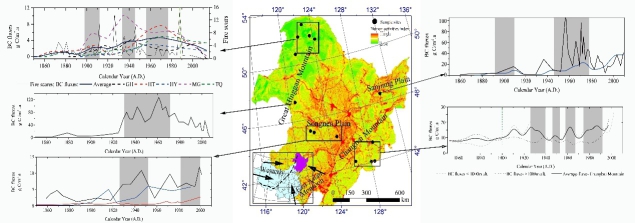Black carbon (BC), produced by incomplete combustion of fossil fuels and biomass, is mainly influenced by human activities in recent hundreds of years. As an important component of the atmospheric aerosol, BC is capable of changing the climate and transporting of POPs. After few days of staying in the atmosphere, BC generally deposits into the soil and could be stored as stable soil carbon pool for several thousand years. Because of the high surface area and stable structure, BC could not only influence the biogeochemical processes in soil carbon pools and also important for the global stable carbon cycle. Evaluating the impact of more BC produced by human activities on climate change and natural ecosystem is a hotspot in several subjects, however, scare study had been reported in the wetland ecosystem.
Research Group of wetland evolution and ecological functions in IGA, started to evaluate the impact of BC on the carbon cycle in wetland ecosystem since 2012. At this moment, BC storage and deposition fluxes and its potential controlling factors in typical wetland distribution regions in northeast China have been reconstructed and evaluated. Results showed that 5.4% of the organic carbon in wetland soils are consisted by BC. As a rough global estimate, 540 Pg of carbon storage in peatlands globally would yield an estimate of 29.1 Pg storage of BC in peatlands, corresponding to about 106.9 Pg CO2are long-term storage in peatland soil carbon pool.
BC deposition fluxes in wetlands were around 10 (from 1 to 15) mg cm-2yr-1 during the last 150 years, which were similar to forest soils and higher than other sedimentary archives. Before the 1980s, higher frequency of fire events caused by human activities during the exploiting period led BC deposition fluxes in Sanjiang Plain and Great Hinggan Mountains appeared several peak values even higher than 100 mg cm-2yr-1.After the 1980s, fire events were controlling and forest protection policies implemented by government, the decreasing trend of regional fire frequency led the BC deposition fluxes in different wetland distribution regions were similar, and increasing influence of regional anthropogenic impacts (e.g. industry sources) became dominant factors lead BC deposition fluxes in eastern regions a bit higher than those in western regions.
Through these studies, BC deposition process and its potential controlling factors in wetland were evaluated and BC storage in wetland ecosystem was estimated firstly around the world. Results and conclusion from these studies are important for evaluating the impact of BC on the carbon cycle in wetland and reconstructing the historical BC cycle in the future studies, and enhance the importance of wetland stable carbon pool on the global carbon cycle.

Reference:
Gao et al.(2017)Land Degradation & Development.https://doi.org/10.1002/ldr.2837;
He et al. (2017)Journal of Soils and Sediments,https://doi.org/10.1007/s11368-017-1825-y;
Gao et al. (2016).Geoderma, https://doi.org/10.1016/j.geoderma.2016.03.021;
He et al. (2015).Plos one,https://doi.org/10.1371/journal.pone.0140834;
Gao et al. (2014). Scientific reports, https://doi.org/10.1038/srep05723
Conatct:
Prof.WANG Guoping,Ph.D.
Key Laboratory of Wetland Ecology and Environment,Northeast Institute of Geography and Agroecology,CAS
Tel:13844097898
E-mail:wangguoping@iga.ac.an